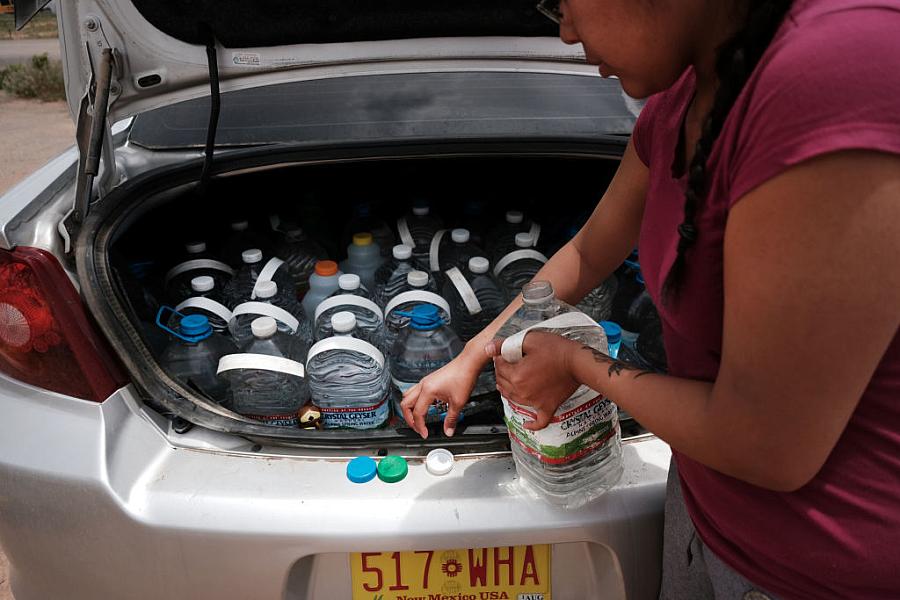We’re exploring how distrust in tap water fuels the kiosk water industry

Photo by Spencer Platt/Getty Images
Too often, journalists take public tap water for granted — until it fails.
Water crises in cities like Flint, Michigan and Jackson, Mississippi prompt breaking news reporting akin to coverage of natural disasters. Television stations and newspapers run photographs of bottled water crates stacked high, with neighbors passing 24-packs to neighbors. These iconic images remind us that when the public’s trust in local water utilities is broken, people turn away from tap water and toward private solutions perceived to be safer.
What these images don’t show is the long-term effects. After emergency funding for bottled water runs dry, many consumers continue to pay a premium for 5-gallon jugs or single-serve bottles. Buying drinking water functions like a tax on people who live in communities that have suffered from poor access to drinking water — or as one recent book calls it, a “distrust premium.” Advocates point out that such consumers pay for water twice: once at the tap and once at the supermarket or water vending kiosk.
Our reporting for the Center for Public Integrity, under the auspices of the 2024 California Health Equity Fellowship, will investigate the kiosk water industry and its relationship to tap water quality. We’ll interview consumers to learn why they came to prefer comparatively expensive jugs of water to the tap water in their homes. We’ll identify communities where demand for kiosk water is especially high and explore the historical factors that help to explain why. And we’ll describe the companies that profit from the sale of water from kiosks as well as the regulatory regime meant to ensure that this water is safe to drink.
We will cover this issue at a critical moment for many under-resourced water utilities. For the first time in decades, the federal government is making a serious investment in water infrastructure. In California alone, the Bipartisan Infrastructure Law is set to bring $510 million in funding to address water infrastructure. A recent report by the Environmental Protection Agency Office of Inspector General describes projected investments in environmental infrastructure nationwide as “an unprecedented amount of funding.”
Our interest in covering drinking water quality and cost grew out of previous reporting.
María Inés first learned about the water sector by covering the cost of tap water in the Great Lakes region between 2007 and 2018. Data she collected showed that low-income communities of color across six cities along the world’s largest supply of fresh water couldn’t keep up with rising tap water costs.
María Inés continued covering Chicago’s Department of Water Management during the pandemic. Her subsequent investigation led to the creation of a program to help low-income Chicagoans pay for their water and sewer bills.
The reporting showed that some communities of color are more likely to lack consistent access to safe tap water — a finding echoed in a growing body of academic research.
People working in the water sector are well aware of the long shadow cast by failures to provide safe drinking water for all. At the One Water Summit in Arizona last fall, we spoke with activists who described their communities’ deep distrust in public water utilities and the impact that having to buy bottled water has on their lives. We also encountered water utility personnel who wish to repair broken trust and to better communicate how their investments in water infrastructure keep the public safe.
Our reporting will build on research that bridges the gap between these two perspectives, probing the relationship between civic engagement and the sale of water in kiosks. We plan to approach our work by analyzing data and by centering the perspectives of kiosk water consumers themselves.
We also aim to teach readers about the differences between tap water and kiosk water, including how each source of water is regulated. One possibility is to test the water dispensed from kiosks and to compare the results to unfiltered water straight from the tap. Along the way, we will seek to address audience questions about how water quality can affect health.
Our work is rooted in the conviction that water is a human right.
We will bring much-needed transparency to the water sector, prompting tap water providers to examine how they communicate with the public about water quality.
We’ll help readers to understand the true costs of bringing water from source to sink, stimulating honest conversations about funding for aging water infrastructure.
Above all, we aim to equip Californians with the information they need to organize for better water — a resource we can’t live without.

